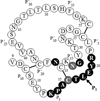Additivity-based design of the strongest possible turkey ovomucoid third domain inhibitors for porcine pancreatic elastase (PPE) and Streptomyces griseus protease B (SGPB)
- PMID: 23892073
- PMCID: PMC3784018
- DOI: 10.1016/j.febslet.2013.07.029
Additivity-based design of the strongest possible turkey ovomucoid third domain inhibitors for porcine pancreatic elastase (PPE) and Streptomyces griseus protease B (SGPB)
Abstract
We describe here successful designs of strong inhibitors for porcine pancreatic elastase (PPE) and Streptomyces griseus protease B (SGPB). For each enzyme two inhibitor variants were designed. In one, the reactive site residue (position 18) was retained and the best residues were substituted at contact positions 13, 14, and 15. In the other variant the best residues were substituted at all contact positions except the reactive site where a Gly was substituted. The four designed variants were: for PPE, T(13)E(14)Y(15)-OMTKY3 and T(13)E(14)Y(15)G(18)M(21)P(32)V(36)-OMTKY3, and for SGPB, S(13)D(14)Y(15)-OMTKY3 and S(13)D(14)Y(15)G(18)I(19)K(21)-OMTKY3. The free energies of association (ΔG(0)) of expressed variants have been measured with the proteases for which they were designed as well as with five other serine proteases and the results are discussed.
Keywords: Additivity; CARL; HLE; Inhibitor design; Kazal inhibitor; OMTKY3; PPE; Protease inhibitor; SGPA and SGPB; SRA; Serine protease; Streptomyces griseus protease A and B. In MEROPS database and recent literature these are listed as Streptogrisin A and B; human leukocyte elastase; porcine pancreatic elastase; sequence to reactivity algorithm; subtilisin Carlsberg; turkey ovomucoid third domain.
Copyright © 2013 Federation of European Biochemical Societies. Published by Elsevier B.V. All rights reserved.
Figures

Similar articles
-
Structural insights into the non-additivity effects in the sequence-to-reactivity algorithm for serine peptidases and their inhibitors.J Mol Biol. 2007 Mar 23;367(2):527-46. doi: 10.1016/j.jmb.2007.01.008. Epub 2007 Jan 9. J Mol Biol. 2007. PMID: 17266986
-
Contribution of peptide bonds to inhibitor-protease binding: crystal structures of the turkey ovomucoid third domain backbone variants OMTKY3-Pro18I and OMTKY3-psi[COO]-Leu18I in complex with Streptomyces griseus proteinase B (SGPB) and the structure of the free inhibitor, OMTKY-3-psi[CH2NH2+]-Asp19I.J Mol Biol. 2001 Jan 26;305(4):839-49. doi: 10.1006/jmbi.2000.4343. J Mol Biol. 2001. PMID: 11162096
-
Deleterious effects of beta-branched residues in the S1 specificity pocket of Streptomyces griseus proteinase B (SGPB): crystal structures of the turkey ovomucoid third domain variants Ile18I, Val18I, Thr18I, and Ser18I in complex with SGPB.Protein Sci. 2000 Jan;9(1):83-94. doi: 10.1110/ps.9.1.83. Protein Sci. 2000. PMID: 10739250 Free PMC article.
-
What can the structures of enzyme-inhibitor complexes tell us about the structures of enzyme substrate complexes?Biochim Biophys Acta. 2000 Mar 7;1477(1-2):324-37. doi: 10.1016/s0167-4838(99)00284-8. Biochim Biophys Acta. 2000. PMID: 10708867 Review.
-
Structure-function relationship of serine protease-protein inhibitor interaction.Acta Biochim Pol. 2001;48(2):419-28. Acta Biochim Pol. 2001. PMID: 11732612 Review.
References
-
- Laskowski M, Jr, Kato I. Protein inhibitors of proteinases. Annu. Rev. Biochem. 1980;49:593–626. - PubMed
-
- Read RJ, James MNG. Introduction to the protein inhibitors: x-ray crystallography. In: Barrett AJ, Salvesen G, editors. Proteinase Inhibitors. Amsterdam: Elsevier Science Publishers B. V.; 1986. pp. 301–336.
-
- Laskowski M, Jr, Qasim MA, Lu S. Interaction of standard mechanism, canonical protein inhibitors with serine proteinases. In: Kleanthous C, editor. Protein-protein recognition. Oxford: Oxford University Press; 2000. pp. 228–279.
-
- Laskowski M, Jr, Qasim MA. What can the structures of enzyme-inhibitor complexes tell us about the structures of enzyme substrate complexes? Biochim. Biophys. Acta - Protein Structure and Molecular Enzymology. 2000;1477:324–337. - PubMed
Publication types
MeSH terms
Substances
Grants and funding
LinkOut - more resources
Full Text Sources
Other Literature Sources

